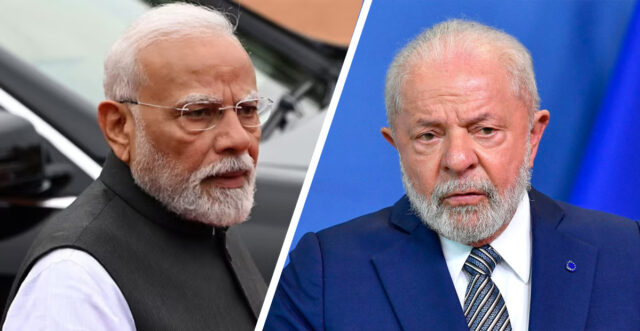
India and Brazil have set an ambitious goal to boost bilateral trade to over US $20 billion by 2030. The move comes as both countries face mounting trade pressure from the United States. India-Brazil bilateral trade now stands at $12 billion.
The renewed push for greater cooperation was discussed during a phone call between Prime Minister Narendra Modi and Brazilian President Luiz Inácio Lula da Silva on Thursday. Both reaffirmed commitment to expanding trade, technology and strategic engagement. The talks reviewed existing bilateral frameworks and explored new areas for integration.
Focus On Trade, Digital Payments
A key outcome of the conversation was the agreement to broaden the scope of the MERCOSUR-India Preferential Trade Agreement. It’s aimed at unlocking more sectors for tariff concessions and easing access to each other’s markets.
The leaders also exchanged information about their national instant payment systems—India’s Unified Payments Interface (UPI) and Brazil’s PIX—as both countries examine avenues for eventual cross-border interoperability.
This aligns with broader BRICS efforts to build alternatives to Western-dominated financial systems, especially in light of U.S. tariff measures targeting key economies in the Global South.
Lula Visit Likely Next Year
President Lula is expected to visit India in 2026 as a state guest. The trip is likely to coincide with India’s hosting of BRICS Summit. Vice President Geraldo Alckmin will visit India this October, accompanied by a delegation of ministers and entrepreneurs under the India-Brazil Trade Monitoring Mechanism.
This visit will focus on deepening cooperation in defence, trade, energy, health, digital inclusion and critical minerals.
Closer BRICS Coordination
The backdrop to this growing India-Brazil alignment is the broader geopolitical recalibration of BRICS. With the U.S. escalating tariff actions against not just China but also India and Brazil, the bloc is accelerating plans to trade in local currencies, boost the role of the New Development Bank and develop alternatives to the SWIFT financial messaging system, say analysts.
According to Prof. Rajan Kumar, School of International Studies: “At the moment, India will seek to negotiate hard with the U.S. for reasonable tariffs. However, inability to seek concessions may push it to search for alternative trading mechanisms with BRICS countries.”
U.S. trade pressure, particularly under the current administration, has only solidified BRICS’ internal cohesion and galvanized efforts to reshape global economic governance. According to political analyst Angelo Giuliano, the Global South is “actively resisting unilateral pressure” and is now coalescing around the idea of a multipolar world order.
Business-to-Business Bridges Being Built
This week, more than 120 Indian and Brazilian business leaders met in Mumbai under the Brazil-India LIDE Forum, reinforcing private sector interest in technology, infrastructure, energy, mining, pharmaceuticals and aviation.
João Doria, former Governor of São Paulo who is now leading the LIDE initiative, stressed the importance of “building practical bridges” between the two economies. “India represents one of the most promising new markets for Brazilian industries. And this is the right moment to elevate our commercial relationship,” he said.
Towards A Resilient Trade Agenda
India and Brazil’s experiences with U.S. trade measures have only added urgency to the push for more resilient and sovereign economic frameworks. While Brazil remains open to negotiating a separate trade deal with Washington, President Lula has been vocal in defending Brazil’s judicial independence and rejecting external interference—especially in relation to U.S. criticism of domestic political matters.
Meanwhile, India has taken a more cautious diplomatic posture, focusing on strengthening ties with like-minded Global South partners while expanding trade and technology linkages.




